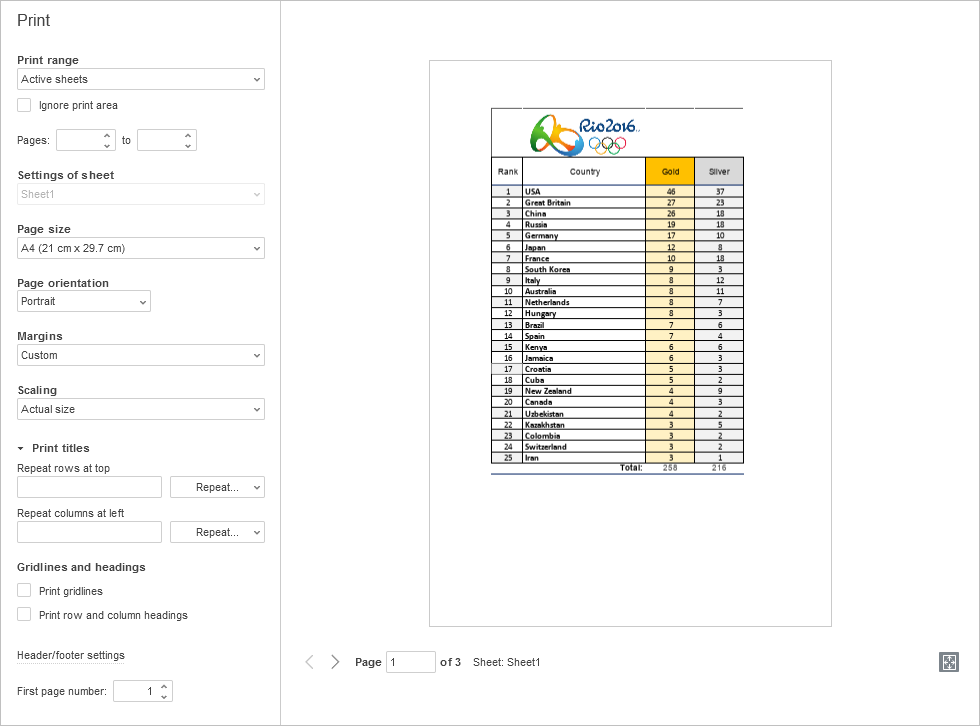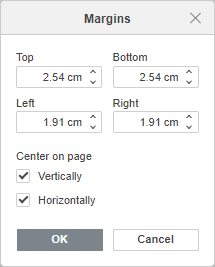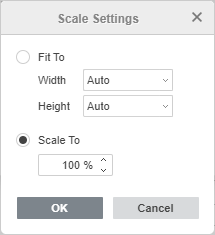Save/print/download your spreadsheet
-
operations with files
-
save files
-
Save, download, print your document
-
Save, print, download your presentation
-
Save, print, download your spreadsheet
-
Save, export, print your document
-
Save, export, print your spreadsheet
-
Save and export your presentation
-
Download and print your document
-
Download and print your spreadsheet
-
print files
-
Save, download, print your document
-
Save, print, download your presentation
-
Save, print, download your spreadsheet
-
Save, export, print your document
-
Save, export, print your spreadsheet
-
Print your presentation
-
Download and print your document
-
Download and print your spreadsheet
-
page orientation
-
page size
-
page margins
Saving
By default, the online Spreadsheet Editor automatically saves your file each 2 seconds when you are working on it preventing your data from loss if the program closes unexpectedly. If you co-edit the file in the Fast mode, the timer requests for updates 25 times a second and saves the changes if they have been made. When the file is being co-edited in the Strict mode, changes are automatically saved at 10-minute intervals. If you need, you can easily select the preferred co-editing mode or disable the Autosave feature on the Advanced Settings page.
To save your current spreadsheet manually in the current format and location,
- click the Save icon on the left side of the editor header, or
- use the Ctrl+S key combination, or
- click the File tab of the top toolbar and select the Save option.
In the desktop version, to prevent data loss if the program closes unexpectedly, you can turn on the Autorecover option on the Advanced Settings page.
In the desktop version, you can save the spreadsheet with another name, in a new location or format,
- click the File tab of the top toolbar,
- select the Save as option,
- choose one of the available formats depending on your needs: XLSX, XLTX, ODS, OTS, CSV, PDF, PDF/A, XLTM, JPG, PNG.
Downloading
In the online version, you can download the resulting spreadsheet onto your computer hard disk drive,
- click the File tab of the top toolbar,
- select the Download as option,
-
choose one of the available formats depending on your needs: XLSX, ODS, CSV, PDF, XLTX, OTS, PDF/A, JPG, PNG.
Note: if you select the CSV format, all features (font formatting, formulas, etc.) except the plain text will not be preserved in the CSV file. If you continue saving, the Choose CSV Options window will open. By default, Unicode (UTF-8) is used as the Encoding type. The default Delimiter is comma (,), but the following options are also available: semicolon (;), colon (:), Tab, Space and Other (this option allows you to set a custom delimiter character).
Saving a copy
In the online version, you can save a copy of the file on your portal,
- click the File tab of the top toolbar,
- select the Save Copy as option,
- choose one of the available formats depending on your needs: XLSX, ODS, CSV, PDF, XLTX, OTS, PDF/A, JPG, PNG,
- select a location of the file on the portal and press Save.
Printing
To print out the current spreadsheet,
- click the Print icon on the left side of the editor header, or
- use the Ctrl+P key combination, or
- click the File tab of the top toolbar and select the Print option.
The Firefox browser enables printing without downloading the document as a .pdf file first.
The spreadsheet Preview and the available printing options will open.
Some of these settings (page Margins, Orientation, Size, Print Area as well as Scale to Fit) are also available on the Layout tab of the top toolbar.

Here you can adjust the following parameters. In the desktop version you can also define the Print sides option to print on one or two sides flipping the pages on long or short edge as well as print the file to PDF or use the Quick print button in the top toolbar to print the file on the last selected or default printer.
-
Print range - specify what to print: Active sheets, All sheets or Selection.
If you previously set a constant print area but want to print the entire sheet, check the Ignore print area box.
- Pages - specify the range of pages for printing. You can enter the numbers manually or use the corresponding arrows.
- Settings of sheet - specify individual print settings for each separate sheet, if you have selected the All Sheets option in the Print range drop-down list.
- Page size - select one of the available sizes from the drop-down list:
- US Letter (21,59cm x 27,94cm)
- US Legal (21,59cm x 35,56cm)
- A4 (21cm x 29,7cm)
- A5 (14,81cm x 20,99cm)
- B5 (17,6cm x 25,01cm)
- Envelope #10 (10,48cm x 24,13cm)
- Envelope DL (11,01cm x 22,01cm)
- Tabloid (27,94cm x 43,17cm)
- AЗ (29,7cm x 42,01cm)
- Tabloid Oversize (29,69cm x 45,72cm)
- ROC 16K (19,68cm x 27,3cm)
- Envelope Choukei 3 (12cm x 23,5cm)
- Super B/A3 (30,5cm x 48,7cm)
- Page orientation - choose the Portrait option if you wish to print vertically on the page, or use the Landscape option to print horizontally.
- Margins - choose one of the availabe presets: Normal, Narrow, or Wide, or choose the Custom option and specify the distance between the worksheet data and the edges of the printed page changing the default sizes in the Top, Bottom, Left and Right fields.
To center data on the printed page, choose the Custom option from the Margins menu, check the Vertically/Horizontally box in the Center on page section, and click OK.

-
Scaling - if you do not want some columns or rows to be printed on the second page, you can shrink sheet contents to fit it on one page by selecting the corresponding option: Actual Size, Fit Sheet on One Page, Fit All Columns on One Page or Fit All Rows on One Page. Leave the Actual Size option to print the sheet without adjusting.
If you choose the Custom Options item from the menu, the Scale Settings window will open:

- Fit To: allows you to select the necessary number of pages you want to fit the printed worksheet to. Select the necessary number of pages from the Width and Height lists.
- Scale To: allows you to enlarge or reduce the scale of the worksheet to fit printed pages by manually specifying the percentage of normal size.
- Print titles - if you want to print row or column titles on every page, use Repeat rows at top and/or Repeat columns at left to indicate the row and the column with the title to repeat, or select one of the available options from the drop-down list: Frozen rows/columns, First row/column or Don't repeat.
- Gridlines and headings - specify the worksheet elements to print by checking the corresponding boxes: Print gridlines and Print row and column headings.
-
Header/footer settings - allow to add some additional information to a printed worksheet, such as date and time, page number, sheet name, etc.
- First page number - specify the number of the first page printed.
- Toggle the Zoom to page switch in the bottom right corner of the screen to display the actual size of the sheets when deactivated, or zoom out when activated.
After you have configured the printing settings click the Print button to save changes and print out the spreadsheet or the Save button to save changes made to printing settings.
All changes you made will be lost if you don't print the spreadsheet or save the changes.
The spreadsheet Preview allows you to navigate a spreadsheet using arrows at the bottom to see how your data will be displayed on a sheet when printed and to correct eventual faults using the print setting above.
In the online version, a PDF file will be generated on the basis of the document. You can open and print it out, or save onto your computer hard disk drive or removable medium to print it out later. Some browsers (e.g. Chrome and Opera) support direct printing.
Setting up the print area
If you want to print the selected cell range only instead of the entire worksheet, you can use the Selection option from the Print range drop-down list. When the workbook is saved, this setting is not saved, it is intended for single use.
If a cell range should be printed frequently, you can set a constant print area on the worksheet. When the workbook is saved, the print area is also saved, it can be used when you open the spreadsheet next time. It's also possible to set several constant print areas in a sheet, in this case each area will be printed on a separate page.
To set the print area:
- select the necessary cell range on the worksheet. To select multiple cell ranges, hold down the Ctrl key,
- switch to the Layout tab of the top toolbar,
- click the arrow next to the Print Area button and select the Set Print Area option.
The created print area is saved when the workbook is saved. When you open the file next time, the specified print area will be printed.
When you create a print area, a Print_Area named range is also automatically created, which is displayed in the Name Manager. To highlight the borders of all the print areas on the current worksheet, you can click the arrow in the name box located to the left of the the formula bar and select the Print_Area name from the name list.
To add cells to the print area:
- open the necessary worksheet where the print area is added,
- select the necessary cell range on the worksheet,
- switch to the Layout tab of the top toolbar,
- click the arrow next to the Print Area button and select the Add to Print Area option.
A new print area will be added. Each print area will be printed on a separate page.
To remove the print area:
- open the necessary worksheet where the print area is added,
- switch to the Layout tab of the top toolbar,
- click the arrow next to the Print Area button and select the Clear Print Area option.
All the existing print areas in this sheet will be removed. Then the entire sheet will be printed.
Return to previous page